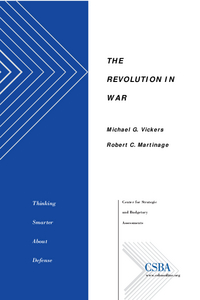
A revolution in war has been underway for nearly three decades. Beginning in the mid–1970s, in an effort to compensate for the numerical superiority of Warsaw Pact forces, the US military sought to exploit a number of asymmetric technological advantages. Despite the demise of the threat for which these “offset” capabilities were created, they have continued to be developed, and have been leveraged to great effect in wars ranging from Desert Storm to Operation Iraqi Freedom.
To date, the revolution in war has been principally characterized by:
- The emergence of all-weather precision war;
- The advent of stealth;
- The rise of unmanned systems;
- The tactical and operational exploitation of space; and
- The emergence of early forms of network-based warfare and joint force integration.
Thus far, the US military has enjoyed a monopoly on the revolution in war. Within the next two decades, however, the revolution could shift from a purely opportunity-based one for the United States to one that portends significant threats, as well as opportunities. If there is competition within the revolution in war, it is likely to be highly asymmetric. It is entirely conceivable, moreover, that a competitor could “leapfrog” the United States in some areas of future competition.
Major advances in the core military capabilities that are underwriting the revolution in war—awareness, connectivity, range, endurance, precision, miniaturization, speed, stealth, automation, and simulation—are likely over the next one or two decades, and significant discontinuities in the conduct of war could lie ahead. The future course of the revolution in war could range from a continuation of current trends and the existing warfare regime, to a “revolution within the revolution” due to asymmetric exploitation of disruptive capabilities (e.g., robust, “anti–access/area denial” networks, offensive information warfare and space warfare capabilities) by strategic competitors, to a successor revolution that would involve a much greater break with the ongoing revolution in war (e.g., the emergence of an unmanned warfare–dominant regime). While the emergence of a revolution within the revolution or a successor revolution is still highly uncertain, we believe that the outcome of six warfare competitions will be determinative of the character of the future warfare regime:
- Evolving anti-access and area-denial capabilities versus current and new forms of power projection;
- Increased capabilities for preemption versus increased denial capabilities;
- Hiders versus finders;
- Space access versus space control;
- Missile attack versus missile defense, information warfare (IW) attack versus IW defense, and biological warfare (BW) attack versus BW defense; and
- Increased capabilities for political–military coercion versus capabilities for counter–coercion.
As these key warfare competitions unfold, discontinuous change could occur within and across the primary warfare dimensions of air, land and sea. New forms of war could emerge in several other dimensions: space, information, and the biological. Air warfare could be transformed from a regime dominated by manned, theater-range, air superiority aircraft to one dominated by extended- range, unmanned, and stealthy platforms. The conduct of land warfare could shift from a regime dominated by mobile, combined-arms, armored forces to one that is dominated by much lighter, stealthier and information-intensive forces that make heavy use of robotics. War at sea could be transformed by the emergence of “anti-navy” capabilities that allow nations to assert a degree of surface control over adjacent maritime areas out to several hundred miles. This development would likely lead to new forms of naval power projection, including increased reliance on undersea warfare and relatively small, stealthy, networked surface vessels.
Increased commercial and military use of space could lead to the emergence of a wide range of offensive and defensive space control capabilities. Computer network attack (CNA) tools and radiofrequency (RF) weapons could be widely used to attack information infrastructures and information-intensive forces. Designer BW and the emergence of biological operations could also figure prominently in an
advanced revolution in military affairs (RMA) regime.



























